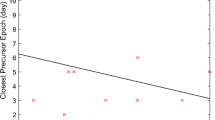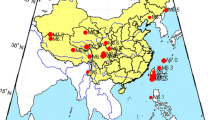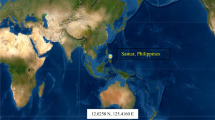Abstract
We study the impact of the severe equatorial earthquakes on the ionospheric Equatorial Ionization Anomaly (EIA) to check the variations in the shape of electron concentrations along the earthquake longitudes as the possible precursors to the earthquakes by considering a case study of a strong Mw 7.3 seismic event from Honduras occurred in 2009. We have observed sharp increments in the atmospheric chemical potential and surface air temperature time series along with an abrupt decrease in the relative humidity simultaneously about 5–8 days before the impending earthquake indicating the procreation of the air ionization due to increased radon activity around the earthquake's epicenter. We further investigated the ionospheric conditions by estimating the total electron content (TEC) from 6 IGS stations. The results suggested that the 2 IGS stations operating within the earthquake preparation area (EPA) showed prominent TEC enhancements about 5 days before the impending earthquake, consistent with the seismic atmospheric circulations. The other 3 IGS stations, operating outside the EPA, did not show any perturbation. These TEC variations are quantified based on two different methods: (1) running interquartile method and (2) method of cognitive recognition (applied on station BOGT). Moreover, the TEC and electron density profiles, retrieved from station BOGT and the ISL probe of the DEMETER satellite, respectively, revealed that the local TEC enhancements further dispersed toward the magnetic equator at higher altitudes by developing an enormous two-hump-like EIA structure near the epicentral longitude that verifies the generation of the seismogenic electric field through air ionization. We believe that our multi-precursory analysis is another step forward in comprehending the seismic lithosphere–ionosphere interactions.









Similar content being viewed by others
Data availability
All the datasets used in this study are publicly available at the following online links: https://disc.gsfc.nasa.gov/datasets?project=MERRA (Atmospheric humidity and air temperature); https://omniweb.gsfc.nasa.gov/ (Geomagnetic Data); https://geomag.colorado.edu/real-time-model-of-the-ionospheric-electric-fields.html (PPEFs); https://cddis.nasa.gov/Data_and_Derived_Products/ (IGS products for TEC estimation); https://data.cosmic.ucar.edu/gnss-ro/ (COSMIC datasets); http://demeter.cnrs-orleans.fr (DEMETER datasets).
References
Abbasi AR, Shah M, Ahmed A, Naqvi NA (2021) Possible ionospheric anomalies associated with the 2009 M w 6.4 Taiwan earthquake from DEMETER and GNSS TEC. Acta Geod Geophys 56(1):77–91. https://doi.org/10.1007/s40328-020-00325-1
Adil MA, Şentürk E, Shah M, Naqvi NA, Saqib M, Abbasi AR (2021a) Atmospheric and ionospheric disturbances associated with the M > 6 earthquakes in the East Asian sector: a case study of two consecutive earthquakes in Taiwan. J Asian Earth Sci 220:104918. https://doi.org/10.1016/j.jseaes.2021.104918
Adil MA, Şentürk E, Pulinets SA, Amory-Mazaudier C (2021b) A lithosphere–atmosphere–ionosphere coupling phenomenon observed before M 7.7 Jamaica Earthquake. Pure Appl Geophys 178:3869–3886. https://doi.org/10.1007/s00024-021-02867-z
Astafyeva E (2019) Ionospheric detection of natural hazards. Rev Geophys 57(4):1265–1288. https://doi.org/10.1029/2019RG000668
Astafyeva E, Heki K, Afraimovich E, Kiryushkin V, Shalimov S (2009) Two-mode long-distance propagation of coseismic ionosphere disturbances. J Geophys Res 114:A10307. https://doi.org/10.1029/2008JA013853
Boyarchuk KA, Karelin AV, Shirokov RV (2006) Bazovaya model’ kinetiki ionizirovannoi atmosfery (The base model of kinetics of the ionized atmosphere). IPG VNII EM, Moscow
Ciraolo L, Azpilicueta F, Brunini C, Meza A, Radicella SM (2007) Calibration errors on experimental slant total electron content (TEC) determined with GPS. J Geod 81(2):111–120. https://doi.org/10.1007/s00190-006-0093-1
Cui Y, Du J, Zhang D, Sun Y (2013) Anomalies of total column CO and O3 associated with great earthquakes in recent years. Nat Hazard 13(10):2513–2519. https://doi.org/10.5194/nhess-13-2513-2013
Dobrovolsky IP, Zubkov SI, Miachkin VI (1979) Estimation of the size of earthquake preparation zones. Pure Appl Geophys 117(5):1025–1044. https://doi.org/10.1007/BF00876083
Geller RJ (1997) Earthquake prediction: a critical review. Geophys J Int 131(3):425–450. https://doi.org/10.1111/j.1365-246X.1997.tb06588.x
Jiao ZH, Zhao J, Shan X (2018) Pre-seismic anomalies from optical satellite observations: a review. Nat Hazard 18(4):1013–1036. https://doi.org/10.5194/nhess-18-1013-2018
Kakinami Y, Liu JY, Tsai LC, Oyama KI (2010) Ionospheric electron content anomalies detected by a FORMOSAT-3/COSMIC empirical model before and after the Wenchuan Earthquake. Int J Remote Sens 31(13):3571–3578. https://doi.org/10.1080/01431161003727788
Li J, Meng G, You X, Zhang R, Shi H, Han Y (2015) Ionospheric total electron content disturbance associated with May 12, 2008, Wenchuan Earthquake. Geod Geodyn 6(2):126–134. https://doi.org/10.1016/j.geog.2015.01.003
Liperovskaya EV, Parrot M, Bogdanov VV, Meister CV, Rodkin MV, Liperovsky VA (2006) On variations of foF2 and F-spread before strong earthquakes in Japan. Nat Hazards Earth Syst Sci 6(5):735–739. https://doi.org/10.5194/nhess-6-735-2006
Liu JY, Chen YI, Pulinets SA, Tsai YB, Chuo YJ (2000) Seismo-ionospheric signatures prior to M ≥ 6.0 Taiwan earthquakes. Geophys Res Lett 27(19):3113–3116. https://doi.org/10.1029/2000GL011395
Liu JY, Chen CY, Sun YY, Lee I-T, Chum J (2019) Fluctuations on vertical profiles of the ionospheric electron density perturbed by the March 11, 2011 M9.0 Tohoku earthquake and tsunami. GPS Solut. https://doi.org/10.1007/s10291-019-0866-7
Liu GC (2001) Ionosphere weighted global positioning system carrier phase ambiguity resolution. Graduate Studies
Mannucci AJ, Wilson BD, Yuan DN, Ho CH, Lindqwister UJ, Runge TF (1998) A global mapping technique for GPS-derived ionospheric total electron content measurements. Radio Sci 33(3):565–582. https://doi.org/10.1029/97RS02707
Marchetti D, De Santis A, D’Arcangelo S, Poggio F, Jin S, Piscini A, Campuzano SA (2020) Magnetic field and electron density anomalies from Swarm satellites preceding the major earthquakes of the 2016–2017 Amatrice-Norcia (Central Italy) seismic sequence. Pure Appl Geophys 177(1):305–319. https://doi.org/10.1007/s00024-019-02138-y
Mollo S, Tuccimei P, Heap MJ, Vinciguerra S, Soligo M, Castelluccio M, Scarlato P, Dingwell DB (2011) Increase in radon emission due to rock failure: an experimental study. Geophys Res Lett 38:14. https://doi.org/10.1029/2011GL047962
Montenbruck O, Hauschild A, Steigenberger P (2014) Differential code bias estimation using multi-GNSS observations and global ionosphere maps. Navig J Inst Navig 61(3):191–201. https://doi.org/10.1002/navi.64
Ouzounov D, Liu D, Chunli K, Cervone G, Kafatos M, Taylor P (2007) Outgoing long wave radiation variability from IR satellite data prior to major earthquakes. Tectonophysics 431(1–4):211–220. https://doi.org/10.1016/j.tecto.2006.05.042
Pulinets S, Davidenko D (2014) Ionospheric precursors of earthquakes and global electric circuit. Adv Space Res 53(5):709–723. https://doi.org/10.1016/j.asr.2013.12.035
Pulinets SA, Davidenko DV (2018) The nocturnal positive ionospheric anomaly of electron density as a short-term earthquake precursor and the possible physical mechanism of its formation. Geomag Aeron 58(4):559–570. https://doi.org/10.1134/S0016793218040126
Pulinets S, Ouzounov D (2018) The possibility of earthquake forecasting: learning from nature. IOP Publishing, Bristol
Pulinets SA, Ouzounov DP, Karelin AV, Davidenko DV (2015) Physical bases of the generation of short-term earthquake precursors: a complex model of ionization-induced geophysical processes in the lithosphere-atmosphere-ionosphere-magnetosphere system. Geomag Aeron 55(4):521–538. https://doi.org/10.1134/S0016793215040131
Pulinets SA, Davidenko DV, Budnikov PA (2021a) Method for cognitive identification of ionospheric precursors of earthquakes. Geomag Aeron 61(1):14–24. https://doi.org/10.1134/S0016793221010126
Pulinets S, Tsidilina M, Ouzounov D, Davidenko D (2021b) From hector mine M7. 1 to Ridgecrest M7. 1 Earthquake. A look from a 20-year perspective. Atmosphere 12(2):262. https://doi.org/10.3390/atmos12020262
Rienecker MM et al (2011) MERRA: NASA’s modern-era retrospective analysis for research and applications. J Clim 24(14):3624–3648. https://doi.org/10.1175/JCLI-D-11-00015.1
Ryu K, Parrot M, Kim SG, Jeong KS, Chae J, Pulinets S, Oyama KI (2014) Suspected seismo-ionospheric coupling observed by satellite measurements and GPS TEC related to the M7. 9 Wenchuan earthquake of May 12 2008. J Geophys Res Space Phys 119(12):10–305. https://doi.org/10.1002/2014JA020613
Şentürk E, Çepni MS (2018) A statistical analysis of seismo-ionospheric TEC anomalies before 63 M w ≥ 5.0 earthquakes in Turkey during 2003–2016. Acta Geophys 66(6):1495–1507. https://doi.org/10.1007/s11600-018-0214-2
Sezen U, Arikan F, Arikan O, Ugurlu O, Sadeghimorad A (2013) Online, automatic, near-real time estimation of GPS-TEC: IONOLAB-TEC. Space Weather 11(5):297–305. https://doi.org/10.1002/swe.20054
Shah M, Abbas A, Adil MA, Ashraf U, de Oliveira-Júnior JF, Tariq MA, Ali A (2022) Possible seismo-ionospheric anomalies associated with M > 5.0 earthquakes during 2000–2020 from GNSS TEC. Adv Space Res. https://doi.org/10.1016/j.asr.2022.04.025
Shi K, Ding H, Guo J, Yu T (2021) Refined seismic-ionospheric effects: case study of Mw 8.2 Chiapas earthquake on September 7, 2017. GPS Solut 25:3. https://doi.org/10.1007/s10291-021-01129-8
Sun Y-Y, Liu J-Y, Tsai H-F, Krankowski A (2017) Global ionosphere map constructed by using total electron content from ground-based GNSS receiver and FORMOSAT-3/COSMIC GPS occultation experiment. GPS Solut 21(4):1583–1591. https://doi.org/10.1007/s10291-017-0635-4
Tronin AA (2010) Satellite remote sensing in seismology. A review. Remote Sens 2(1):124–150. https://doi.org/10.3390/rs2010124
Acknowledgements
The authors are extremely thankful to two anonymous referees for constructive comments and suggestions. We would like to pay gratitude to IGS, NASA OmniWeb, and COSMIC Data Analysis and Archive Center (CDAAC) for sharing GNSS, space weather, and TEC profile data, respectively. We are also grateful to DEMETER, NASA's MERRA, and the Cooperative Institute for Research in Environmental Sciences (CIRES) for sharing their valuable data. Furthermore, we are also grateful to USGS for providing earthquake information.
Author information
Authors and Affiliations
Corresponding author
Additional information
Publisher's Note
Springer Nature remains neutral with regard to jurisdictional claims in published maps and institutional affiliations.
Rights and permissions
Springer Nature or its licensor holds exclusive rights to this article under a publishing agreement with the author(s) or other rightsholder(s); author self-archiving of the accepted manuscript version of this article is solely governed by the terms of such publishing agreement and applicable law.
About this article
Cite this article
Adil, M.A., Pulinets, S.A., Şentürk, E. et al. GNSS atmosphere seismology for equatorial earthquakes: a case study from Central America. GPS Solut 26, 112 (2022). https://doi.org/10.1007/s10291-022-01300-9
Received:
Accepted:
Published:
DOI: https://doi.org/10.1007/s10291-022-01300-9




